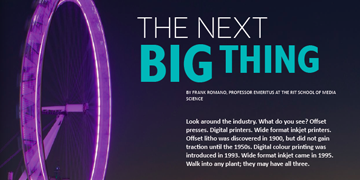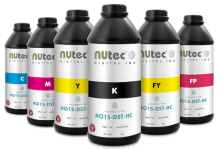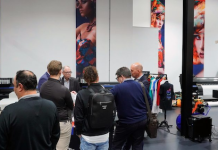By Frank Romano, Professor RIT
Look around the industry. What do you see? Offset presses. Digital printers. Wide format inkjet printers. Offset litho was discovered in 1900, but did not gain traction until the 1950s. Digital colour printing was introduced in 1993. Wide format inkjet came in 1995. Walk into any plant; they may have all three. This article appears in the latest Sign Africa Journal.
It took a while for all three printing technologies to find their place in print production. All three were challenged by a status quo. Offset was once described as ‘only for quick and dirty printing’. Ironically, they said the same for digital colour. The president of Xerox was quoted in the Wall Street Journal saying almost the same about inkjet printing (2004). Now Xerox is becoming a force in inkjet.
Yet, all three processes make money for printers. What will be the next big thing? The technology is already here. We just have to find markets for it.
Flatbed UV inkjet can print on any substrate: plastics, wood, glass, board, metal, ceramics, textiles, carpeting, and more. Commercial printers print on paper. Where is the market for printing on all those other substrates? This brings us to the market called functional or industrial printing.
Printers print books, periodical, promotional, informational, and utility materials. Where is there a market for printing on textiles? How about the covering for your chair or sofa? Or printing on glass to give you a Tiffany stained glass look? How about personalised wallpaper? Or artwork that matches a colour scheme? Or personalised artwork on your carpet?
Only a few of us can afford home decorators. We use our own aesthetic sense. Some of us use the internet and order from West Elm or Wayfair or even Etsy. There is a store in malls called Accessorize for your clothing. Soon there will be a version for your home. It is all about lifestyle.
Home decor is said to be around R7 trillion ($664 billion) market worldwide. Most of the ads on local TV: cars and furniture stores. One merchant is Home Goods and I watch shoppers filling their carts with throw pillows and home items of all kinds. I hear things like ‘I wish this was in blue to go with my sofa’.
There is a market here for printers. It will be through home decorators or direct. It is a print market, but is on much more than paper. It will require new knowledge—of substrates, inks, laser die cutting, embossing, and finishing. Xerox just introduced a printer that prints on odd-shaped objects. How about printing the base of a lamp or artwork? Or making one with 3D Printing?
We will need to learn and apply colour in new ways. Imagine a Pantone swatch book on metal. It would weigh a ton. No one predicted that wide format inkjet would open a new market for printers for signage, vehicle wraps, building wraps, back drops, and more. Go back and look. The first wide format printers were introduced as proofers for colour printing.
As Benny Landa has said: anything that can go digital will go digital. That is why the growth markets are packaging and new media—and by media I mean new substrates. In other words, the future of print involves stuff that cannot go digital.
It is Variable Data Printing for home decoration. It is personalised home printing. It is personalised decoration. It is high margin. And it is a market that is starting now.
Sign Africa Journal https://www.signafrica.com/magazine















